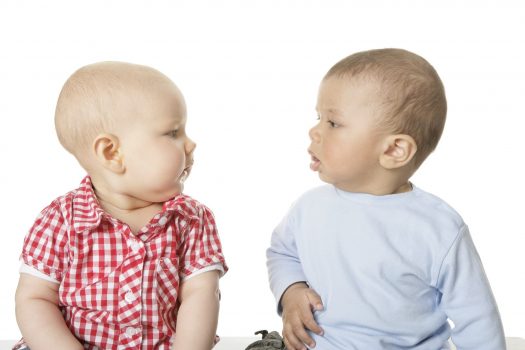by Mollie Romano, Ph.D., SLP-CCC
Infants spend much of their very first year getting to know their caregivers, as caregivers get to know them! Even after a few weeks of life, sensitive and nurturing parents know what their baby likes and doesn’t like, their habits, their temperaments, and their quirks as they watch development unfold rapidly. While my own children are bigger now, I love watching my friends get to know their own newborns. I follow their postings on Facebook as they muse over the way their newborn sleeps with his eyes partially open, or the funny sounds she makes after eating just before falling asleep. These little things mark the growing connection between caregivers and their children, and it sets the stage for communication development within the context of those early relationships.
A few questions came up regarding the early vocalizations infants begin to intentionally produce around 8 weeks of age. I mentioned how the “control of phonation” stage typically involves vowel production. There is minimal normative data that points to a specific order of acquisition of vowel sounds. However, what is known about motor development provides some clues. In most areas of development, babies master the easier skills first and use them to build more advanced skills. In terms of speech sounds, vowels are very easy to produce – all you have to do is move your tongue to a different spot in your mouth and send some sounds out of your vocal folds. Easy as pie compared to some consonant sounds that require specific positions in the mouth! Because infants in this age range do not yet have much head and neck control and are on their backs much of the time, gravity pulls the tongue back in the mouth. For this reason, the so-called back vowels, like “ah” and “oooo” are some of the early sounds infants begin to vocalize intentionally! But in short order, they begin playing around with other sounds too, and it is a delight to hear!
Additionally, all that vocal play isn’t just about the sounds themselves, it is about drawing in a responsive partner who makes those silly sounds back and engages in a “conversation” with the baby. Yet some children do not produce the inventory of speech sounds we should hear in the first year of life. Children with hearing loss, for instance, do not vocalize with the same variety of sounds as a typical infant would, and this is an early marker for detecting a problem with hearing. Likewise, because these sounds develop in a social context, children with social communication difficulties like autism spectrum disorder (ASD) often show differences in speech sound production. Data indicate that infants and toddlers with ASD use speech sounds for communication at a lower rate than their peers, but they also vocalize to show distress at a higher rate than typical infants [1]. Other special populations begin to show differences in speech sound development in their first year as well. Infants with Down syndrome typically begin by vocalizing with vowels and at a similar rate as their peers, but by the end of the first year, they do not use as wide a range of consonants or patterns of syllables in their babbling [2].
Parents and teachers can do so much to support sound development by imitating the sounds that a baby makes, and by adding on a few additional sounds! No fancy tools or gadgets are required! By engaging with the baby, copying her first, and adding on sounds in a simple and fun way, caregivers can build up or increase those sounds.
In fact, many caregivers just do this naturally through what used to be called “motherese.” “Motherese,” or the more gender equitable “infant-directed speech,” involves using an exaggerated intonation, a higher pitch, and lots more repetition. Interestingly, research shows that it works and that instinctively caregivers use infant-directed speech around the world! Infant-directed speech keeps little ones more engaged and conversant and helps them participate in those early conversations. It may feel silly for some adults, but it works and is an effective way to draw infants into back and forth exchanges with a social partner. For children who are dual language learners, this fun, exaggerated speech could aid each of their language systems even more!
References
- Plumb, A. M., & Wetherby, A. M. (2013). Vocalization development in toddlers with autism spectrum disorder. Journal of Speech, Language, and Hearing Research, 56(2), 721-734.
- Sokol, S. B., & Fey, M. E. (2013). Consonant and syllable complexity of toddlers with Down syndrome and mixed-aetiology developmental delays. International journal of speech-language pathology, 15(6), 575-585.
Image from Pixabay.com, CC0















